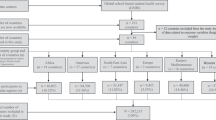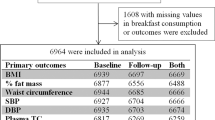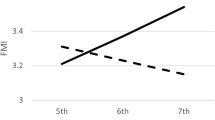Abstract
Objective/Background:
To investigate the association between skipping breakfast, alcohol consumption and physical inactivity with overweight and obesity in adolescents. The design comprises cross-sectional electronic health survey (E-MOVO).
Subjects/Methods:
Over 35 000 Dutch adolescents in grade 2 (13–14 years of age) and grade 4 (15–16 years of age) of secondary educational schools were recruited by seven community health services. Analyses were performed on 25 176 adolescents. Body mass index was calculated from self-reported body weight and height. Frequency of skipping breakfast per week, amount of alcoholic drinks consumed per occasion, and numbers of physical active days per week were considered as determinants for overweight and obesity.
Results:
In grade 2, adjusted odds ratios for the association with overweight were 2.17 (95% CI: 1.66–2.85) for skipping breakfast, 1.86 (1.36–2.55) for alcohol consumption and 1.73 (1.19–2.51) for physical inactivity. Statistically significant associations with overweight were also found in grade 4. In grade 2, dose–response relations (P for trend <0.05) were present between all risk factors and overweight. In a multivariate model containing all risk factors, breakfast skipping showed the strongest relation with overweight (OR 1.68, 95% CI 1.43–1.97 for grade 2, OR 1.32 95% CI 1.14–1.54 for grade 4) and obesity.
Conclusions:
Skipping breakfast, alcohol consumption and physical inactivity were associated with overweight in second and fourth grade adolescents. The associations were strongest for younger adolescents. The most important risk factor for overweight and obesity was skipping breakfast.
This is a preview of subscription content, access via your institution
Access options
Subscribe to this journal
Receive 12 print issues and online access
$259.00 per year
only $21.58 per issue
Buy this article
- Purchase on Springer Link
- Instant access to full article PDF
Prices may be subject to local taxes which are calculated during checkout
Similar content being viewed by others
References
Beker M, Breedveld K, van den Broek A, de Haan J, Herweijer L, Huysmans F et al. (2002). In: Zeijl E (ed). Rapportage jeugd 2002. Social and Cultural Planning Office of the Netherlands: The Hague.
Berkey CS, Rockett HRH, Gillman MW, Field AE, Colditz GA (2003). Longitudinal study of skipping breakfast and weight change in adolescents. Int J Obes 27, 1258–1266.
Bobak M, Skodova Z, Marmot M (2003). Beer and obesity: a cross-sectional study. Eur J Clin Nutr 57, 1250–1253.
Brener ND, McManus T, Galuska DA, Lowry F, Wechsler H (2003). Reliability and validity of self-reported height and weight among high school students. J Adolesc Health 32, 281–287.
Breslow RA, Smothers BA (2005). Drinking patterns and body mass index in never smokers. National Health Interview Survey, 1997–2001. Am J Epidemiol 161, 368–376.
Brugman E, Spee-van der Wekke J, Verloove-Vanhorick SP (1998). Breakfast-skipping in children and young adolescents in the Netherlands. Eur J Public Health 52, 325–328.
Cho S, Dietrich M, Brown CJP, Clard CA, Block G (2003). The effect of breakfast type on total energy intake and body mass index: results from the third National Health and Nutrition Examination Survey (NHANES III). J Am Coll Nutr 22, 96–302.
Cole TJ, Bellizzi MC, Flegal KM, Dietz WH (2000). Establishing a standard definition for child overweight and obesity worldwide: International Survey. BMJ 320, 1–6.
Crawley HF, Portides G (1995). Self-reported versus measured height, weight and body mass index amongst 16–17 year old British teenagers. Int J Obes Relat Metab Disord 19, 579–584.
Guo SS, Chumlea WC (1999). Tracking of body mass index in children in relation to overweight in adulthood. Am J Clin Nutr 70, 145S–148S.
Health Council of the Netherlands: Committee on Trend in Food Consumption (2002). Significant trends in food consumption in the Netherlands. Health Council of the Netherlands: The Hague.
Hirasing RA, Fredriks AM, van Buuren S, Verloove-Vanhorick SP, Wit JM (2001). Toegenomen prevalentie van overgewicht en obesitas bij Nederlandse kinderen en signalering daarvan aan de hand van internationale normen en nieuwe referentiediagrammen. Ned Tijdschr Geneeskd 145, 1303–1308.
Hulshof KFAM, Brussaard JH, Kruizinga AG, Telman J, Löwik MRH (2003). Socio-economic status, dietary intake and 10y trends: the Dutch National Food Consumption Survey. Eur J Clin Nutr 57, 128–137.
Kemper HCG, Ooijendijk WTM, Stiggelbout M (2000). Consensus over de Nederlandse norm voor gezond bewegen. TSG 78, 180–183.
Kemper HCG, Post GB, Twisk JWR, Van Mechelen W (1999). Lifestyle and obesity in adolescence and young adulthood: results from the Amsterdam Growth And Health Longitudinal Study (AGAHLS). Int J Obes 23, S34–S40.
Keski-Rahkonen A, Kaprio J, Rissanen A, Virkkunen M, Rose RJ (2003). Breakfast skipping and health-compromising behaviors in adolescents and adults. Eur J Clin Nutr 57, 842–853.
Knol FA (1998). Van hoog naar laag; van laag naar hoog (in Dutch). (From high to low; from low to high). Social and Cultural Planning Office of the Netherlands: The Hague.
Kreijl CF, Knaap AGAC, Busch MCM, Havelaar AH, Kramers PGN, Kromhout D et al. (2004). In: Verkley H (ed). Onseten Gemeten. Bilthoven, National Institute for Public Health and the Environment.
L'Abée D (2001). Cijfers in beweging. Een overzicht en analyse van kwantitatieve gegevens over jeugd, sport en bewegen. Netherlands Institute for Sport and Physical Activity: Arnhem.
Lahti-Koski M, Pietinen P, Heliövaara M, Vartiainen E (2002). Associations of body mass index and obesity with physical activity, food choices, alcohol intake, and smoking in the 1982–1997 FINRISK Studies. Am J Clin Nutr 75, 809–817.
Netherlands Nutrition Centre (1998). Zo eet Nederland 1998. (Dutch National Food Consumption Survey 1998). Netherlands Nutrition Centre: The Hague.
Paavola M, Vartiainen E, Haukkala A (2004). Smoking, alcohol use, and physical activity: a 13-year longitudinal study ranging from adolescence into adulthood. J Adolesc Health 35, 238–244.
Ruxron CHS, Kirk TR (1997). Breakfast: a review of associations with measures of dietary intake, physiology and biochemistry. Br J Nutr 78, 199–213.
Shapiro JR, Anderson DA (2003). The effects of restraint, gender, and Body Mass Index on the accuracy of self-reported weight. Int J Eat Disord 34, 177–180.
Sjöberg A, Hallberg L, Höglund D, Hulthén L (2003). Meal pattern, food choice, nutrient intake and lifestyle factors in The Göteborg Adolescence Study. Eur J Clin Nutr 57, 1569–1578.
Strauss RS (1999). Comparison of measured and self-reported weight and height in a cross-sectional sample of young adolescents. Int J Obes 23, 904–908.
Statistics Netherlands (2003). Jeugd 2003, cijfers en feiten. Statistics Netherlands: Voorburg, pp 51–69.
Suter PM (2004). Alcohol, nutrition and health maintenance: selected aspects. Proc Nutr Soc 63, 81–88.
Trost SG, Kerr LM, Ward DS, Pate SS (2001). Physical activity and determinants of physical activity in obese and non-obese children. Int J Obes 25, 822–829.
Van Buuren S (2004). Afkapwaarden van de ‘body-mass index’ (BMI) voor ondergewicht van Nederlandse kinderen. Ned Tijdschr Geneeskd 148, 1967–1972.
Van den Hurk K, Van Dommelen P, De Wilde JA, Verkerk PH, Van Buuren S, HiraSing RA, The Netherlands Organisation for Applied Scientific Research [TNO] (2006). Prevalentie van overgewicht en obesitas bij jeugdigen 4–15 jaar in de preiode 2002–2004. [Prevalence of overweight and obesity in youth aged 4–15 years old in the period 2002–2004. In Dutch] TNO Kwaliteit van Leven: Leiden.
van Oers JAM (ed) (2002). Gezondheid op Koers? Volksgezondheid Toekomst Verkenning 2002 (in Dutch). (Health on Course? The 2002 Dutch Public Health Status and Forecasts Report). Bohn Stafleu Van Loghum: Houten.
Wang Z, Patterson CM, Hills AP (2002). A comparison of self-reported and measured height, weight and BMI in Australian adolescents. Aust N Z J Public Health 26, 473–478.
Wannamethee SG, Shaper AG (2003). Alcohol, body weight, and weight gain in middle-aged men. Am J Clin Nutr 77, 1312–1317.
Wardle J, Jarvis MJ, Steggles N, Sutton S, Williamson S, Farrimond H et al (2003). Socioeconomic disparities in cancer-risk behaviours in adolescence: baseline results from the Health Behaviour in Teenagers Study (HABITS). Prev Med 36, 721–730.
Wendel-Vos GC, Schuit AJ, Saris WH, Kromhout D (2003). Reproducibility and relative validity of the short questionnaire to assess health-enhancing physical activity. J Clin Epidemiol 56, 1163–1169.
Westerterp KR, Prentice AM, Jequier E (1999). Alcohol and body weight. In: McDonald I (ed). Health Issues Related to Alcohol Consumption. Blackwell Science Ltd: London, pp 103–123.
World Health Organization (2002). Diet, Nutrition and the Prevention of Chronic Diseases. World Health Organization: Geneva.
Yeomans MR (2004). Effects of alcohol on food and energy intake in human subjects: evidence for passive and active over-consumption of energy. Br J Nutr 92 (Suppl 1), S31–S34.
Author information
Authors and Affiliations
Corresponding author
Rights and permissions
About this article
Cite this article
Croezen, S., Visscher, T., ter Bogt, N. et al. Skipping breakfast, alcohol consumption and physical inactivity as risk factors for overweight and obesity in adolescents: results of the E-MOVO project. Eur J Clin Nutr 63, 405–412 (2009). https://doi.org/10.1038/sj.ejcn.1602950
Received:
Revised:
Accepted:
Published:
Issue Date:
DOI: https://doi.org/10.1038/sj.ejcn.1602950
Keywords
This article is cited by
-
Relationship between energy balance-related behaviors and personal and family factors in overweight/obese primary school students aged 10–12 years in China: a cross-sectional study
BMC Public Health (2022)
-
Breakfast skipping and its relationship with academic performance in Ethiopian school-aged children, 2019
BMC Nutrition (2022)
-
Breakfast prevalence of medical students is higher than students from nonmedical faculties in Inner Mongolia Medical University
European Journal of Clinical Nutrition (2020)
-
Longitudinal changes in body composition and waist circumference by self-reported levels of physical activity in leisure among adolescents: the Tromsø study, Fit Futures
BMC Sports Science, Medicine and Rehabilitation (2019)
-
The link between breakfast skipping and overweigh/obesity in children and adolescents: a meta-analysis of observational studies
Journal of Diabetes & Metabolic Disorders (2019)



